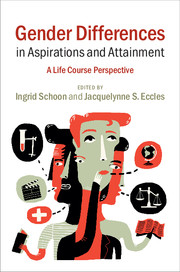Book contents
- Frontmatter
- Contents
- List of Figures
- List of Tables
- Notes on Contributors
- List of Abbreviations (selected)
- Part I Introduction
- Part II The early school years
- Part III Career planning during adolescence
- Part IV Choosing a science career
- 9 Do teenagers want to become scientists?
- 10 Predicting career aspirations and university majors from academic ability and self-concept
- 11 Does priority matter?
- 12 Gender differences in personal aptitudes and motivational beliefs for achievement in and commitment to math and science fields
- 13 What happens to high-achieving females after high school?
- 14 Young people, gender, and science
- 15 Motivational affordances in school versus work contexts advantage different individuals
- Part V Longer-term consequences of early experiences
- Part VI The role of context
- Index
- References
14 - Young people, gender, and science
Does an early interest lead to a job in SET? A longitudinal view from the BHPS youth data
Published online by Cambridge University Press: 05 October 2014
- Frontmatter
- Contents
- List of Figures
- List of Tables
- Notes on Contributors
- List of Abbreviations (selected)
- Part I Introduction
- Part II The early school years
- Part III Career planning during adolescence
- Part IV Choosing a science career
- 9 Do teenagers want to become scientists?
- 10 Predicting career aspirations and university majors from academic ability and self-concept
- 11 Does priority matter?
- 12 Gender differences in personal aptitudes and motivational beliefs for achievement in and commitment to math and science fields
- 13 What happens to high-achieving females after high school?
- 14 Young people, gender, and science
- 15 Motivational affordances in school versus work contexts advantage different individuals
- Part V Longer-term consequences of early experiences
- Part VI The role of context
- Index
- References
Summary
Abstract
This chapter examines the role of teenage career aspirations in predicting later outcomes. In particular we focus on young adolescent males and females who show an interest in SET (science, engineering, and technology) careers. We present the results of secondary analysis that we carried out on the British Youth Survey, which is part of the British Household Panel Survey. Looking at data from a recent cohort, we investigate trends in aspirations over time. Our analysis focuses on four research questions: first, identifying young people’s future aspirations, more specifically their aspirations to get into SET, and the ways in which these relate to family background and gender; second, looking at whether an early interest in science leads to having a SET job as an adult; third, investigating the extent to which young people who aspire to a career in SET may be seeking to reproduce family patterns by following in the footsteps of their parents; and fourth, looking at how those young people who express an interest in SET speak of their career ambitions in relation to family aspirations. Before presenting the results of the analysis we clarify the different working definitions for SET occupations that we adopt in this study. We first present the quantitative cross-sectional and longitudinal results that link youth and adult data in the sample. Second, we present results of the qualitative analysis of future aspirations. Finally, we draw some policy implications concerning possible ways of improving the image of science to reduce the gender gap and encourage more young people to aspire to SET careers.
- Type
- Chapter
- Information
- Gender Differences in Aspirations and AttainmentA Life Course Perspective, pp. 321 - 345Publisher: Cambridge University PressPrint publication year: 2014
References
- 3
- Cited by

